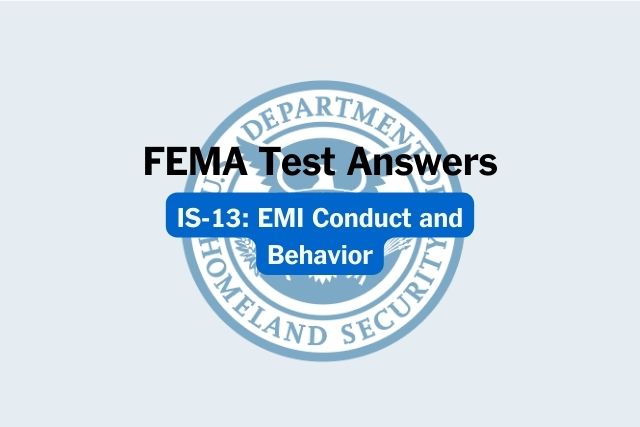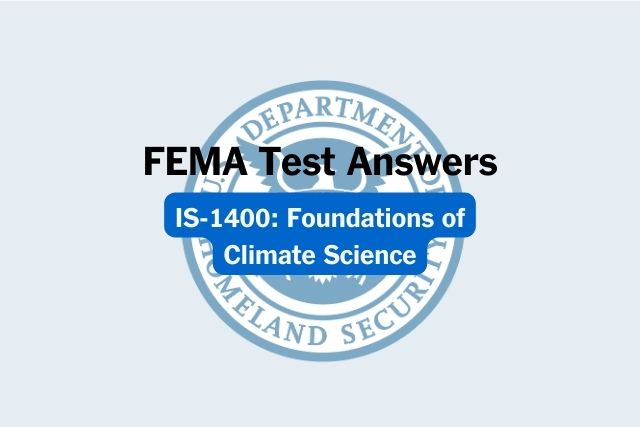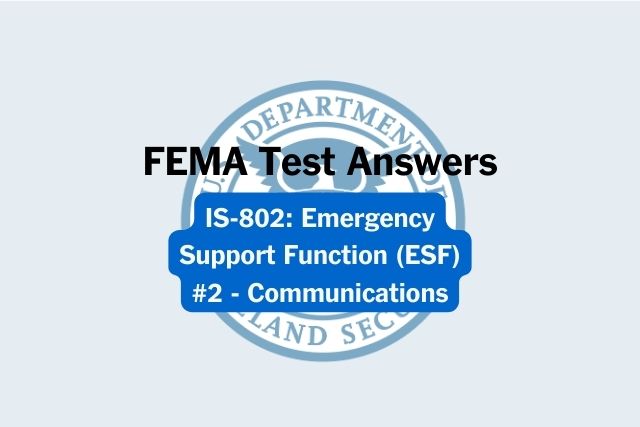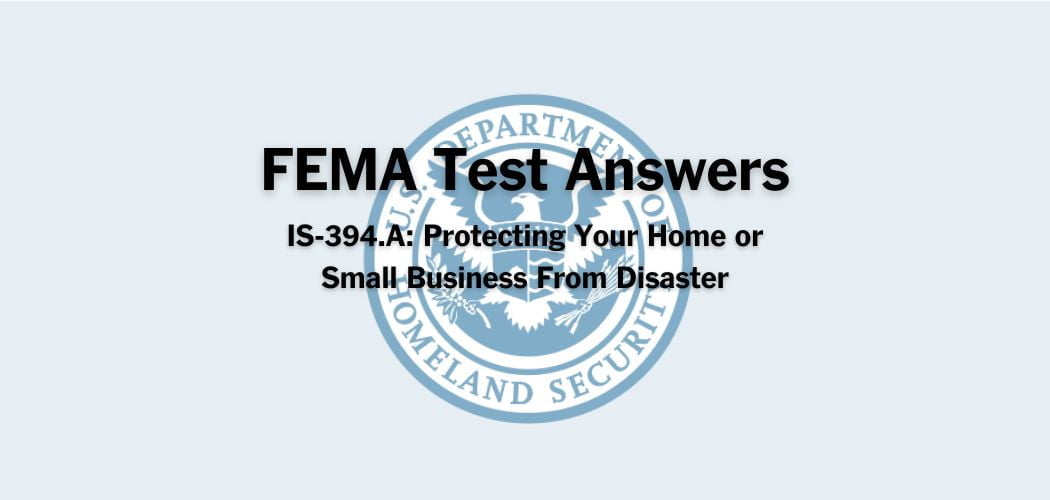Overview: The FEMA IS-1103.A course was published on 6/8/2017 to provide an in-depth look at the Elevation Certificate (FEMA form 086-033 expires November 30, 2018) along with relevant resources to answer your questions.
Primary audience: The IS-1103.A course is for Land Surveyors and other licensed professionals who may be retained to produce an FEMA NFIP elevation certificate. The secondary audience for this course is floodplain management professionals.
Prerequisites
FEMA IS-1103.A test answers
Each time this test is loaded, you will receive a unique set of questions and answers. The test questions are scrambled to protect the integrity of the exam.
Question 1. The National Geodetic Service (NGS) has an online elevation datum conversion tool called VERTCON available for converting NGVD 1929 to NAVD 1988.
A. TRUE✅
B. FALSE
Question 2. A surveyor, architect, or engineer must be authorized by state law to certify a FEMA Elevation Certificate.
A. TRUE✅
B. FALSE
Question 3. The information that Tran, the engineer, posts in EC Item C2 needs to correspond with B9.
A. TRUE
B. FALSE✅
Question 4. The “Acceptance Criteria for Automatic Foundation Flood Vents” form may be used by local floodplain administrators and insurance professionals to document engineered flood openings and devices.
A. TRUE✅
B. FALSE
Question 5. Who can approve engineered flood vents?
A. A surveyor
B. ICC-ES and the flood vent manufacturer✅
C. An engineer
Question 6. The floodproofed residential basement credit may be applied in every participating NFIP community.
A. TRUE
B. FALSE✅
Question 7. Which document may not be required to rate insurance for a floodproofed non-residential building?
A. Floodproofing Certificate
B. A certification that the building is watertight with walls impermeable to the passage of water
C. Elevation Certificate
D. A comprehensive Maintenance Plan for the entire structure✅
E. Photographs of the floodproofing protection to the building
Question 8. When using a floodproofing certificate, an insurance agent will determine the Elevation Difference (LFE minus BFE) for rating by subtracting one foot from the Lowest Floor Elevation or the floodproofed elevation, whichever is greater.
A. TRUE
B. FALSE✅
Question 9. A common Item C2.e, Machinery & Equipment error is:
A. Adding the M&E on an open platform
B. Adding the M&E in an enclosure
C. Leaving M&E item blank✅
D. Adding the M&E in the garage
Question 10. A registered professional engineer or architect must certify a V Zone Design Certificate.
A. TRUE✅
B. FALSE
Question 11. Karen McHugh, the floodplain administrator, has completed EC Sections A, B, and C. Is there anything else on the EC for her to complete?
A. Section E
B. Section G
C. Section F✅
Question 12. Surveyors and engineers can remove buildings from the SFHA.
A. TRUE
B. FALSE✅
Question 13. If A8.d or A9.d is selected on the EC, an Individual Engineered Flood Openings Certification must be submitted with the flood insurance application.
A. TRUE
B. FALSE✅
Question 14. Which of these documents may replace an Elevation Certificate?
A. A statement from the surveyor stating the building is out of the SFHA
B. A non-residential building floodproofing certificate✅
C. An Individual Engineered Flood Openings Certification or ICC-ES Evaluation Report
Question 15. To calculate full-risk rating for flood insurance, an Elevation Certificate is required in what flood zones?
A. A and V Zones✅
B. C or X Zones
C. B or shaded X Zones
Question 16. Hank Jones, the surveyor, doesn’t need to worry about providing a description of the Machinery & Equipment on Page 2 in the Comments Section.
A. TRUE
B. FALSE✅
Question 17. Carter Thomas, the engineer, is calculating the Base Flood Elevation using the Flood Insurance Study. Carter needs to calculate the BFE to the nearest:
A. Foot
B. Tenth of a foot✅
C. One-half foot
Question 18. Charlie Jones, the surveyor, didn’t know the answer to A8.d and decided to leave the item blank. This is okay since Charlie couldn’t gain access to the crawlspace under the building.
A. TRUE
B. FALSE✅
Question 19. If an attached garage in the SFHA doesn’t have proper flood openings, you should just leave that line blank.
A. TRUE
B. FALSE✅
Question 20. The Flood Insurance Rate Map (FIRM) Base Flood Elevation (BFE) is more accurate than the Flood Insurance Study BFE.
A. TRUE✅
B. FALSE
Question 21. Sections E and F may be used when a survey is not required for Zone AO and Zone A (without BFE). The property owner may not complete EC Section E and sign Section F.
A. TRUE✅
B. FALSE
Question 22. Chris James, the surveyor, was completing an EC. Chris was unsure if the building was located in a Coastal Barrier Resources System (CBRS). Where would Chris find this information?
A. Lowest Floor Guide
B. VERTCON
C. NFIP Flood Insurance Manual✅
Question 23. The building diagrams associated with EC Section A, Item 8 are:
A. EC Building Diagram 1A
B. EC Building Diagram 6✅
C. EC Building Diagram 3
Question 24. As a stand-alone document, the Elevation Certificate can change a flood zone from AE to X.
A. TRUE
B. FALSE✅
Question 25. If there are items left blank on the EC, a community may lose CRS credits.
A. TRUE✅
B. FALSE
Question 26. There is no floodplain administrator or contact for each NFIP participating community.
A. TRUE
B. FALSE✅
Question 27. The floodproofed non-residential building credit may be applied in most NFIP Regular Program communities in certain A Zones only.
A. TRUE
B. FALSE✅
Question 28. Sue has a building in the SFHA with an enclosure and needs an EC. Where on the EC is the information regarding the enclosure and flood openings?
A. A8.a, b, c, d✅
B. C2.a
C. D
D. B9
Question 29. FEMA must approve communities for the floodproofed basement exception. A listing of FEMA-approved communities with floodproofed basements may be found in:
A. VERTCON
B. The Flood Insurance Manual, CBRS Section
C. The Flood Insurance Manual, Certifications Section✅
D. The Lowest Floor Guide
Question 30. In certain circumstances, floodproofing may be permitted as an alternative to elevating to or above the BFE; however, a floodproofing design certification is required. The community must be approved by FEMA to receive the floodproofed basement exception credit.
A. TRUE
B. FALSE✅
Question 31. If a property owner wants to use a historic flood map, that information may be placed in Section D, Comments on Page 2 of the Elevation Certificate.
A. TRUE✅
B. FALSE
Question 32. The newer vertical control datum established as a national standard reference datum for elevations is:
A. NGVD 1929
B. NAVD 1988✅
Question 33. The surveyor, architect, or engineer chooses the building diagram that closely resembles the building being certified and enters it where on the EC?
A. Section A, Item 7
B. Section A, Item 9
C. Section A, Item 8✅
Question 34. Proper flood openings equalize flood water pressure and reduce flood risk.
A. TRUE✅
B. FALSE
Question 35. How can NFIP participating communities reduce flood risk?
A. By allowing new construction in the floodplain
B. By elevating buildings above the BFE✅
C. By allowing construction with flood openings 2′ above the grade



